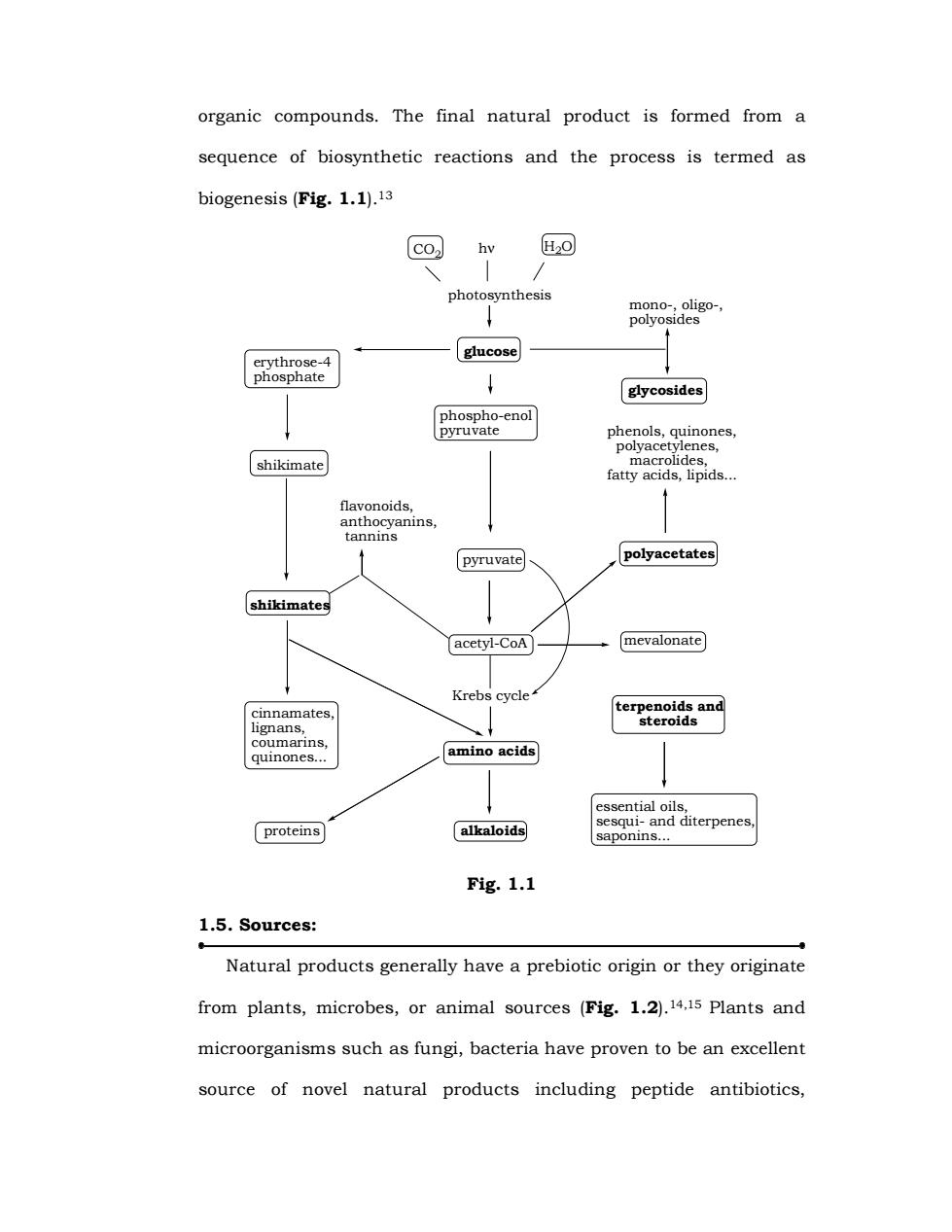
organic compounds.The final natural product is formed from a sequence of biosynthetic reactions and the process is termed as biogenesis(Fig.1.1).13 H.O glucose shikimate nins, pyruvate polyacetates shikimates acetyl-CoA mevalonate reb terp8Rol。nd coumarins amino acids proteins alkaloids Fg.1.1 1.5.Sources: Natural products generally have a prebiotic origin or they originate from plants,microbes,or animal sources (Fig.1.2).14.5 Plants and microorganisms such as fungi,bacteria have proven to be an excellent source of novel natural products including peptide antibiotics
organic compounds. The final natural product is formed from a sequence of biosynthetic reactions and the process is termed as biogenesis (Fig. 1.1).13 CO2 hν photosynthesis H2O erythrose-4 phosphate glucose mono-, oligo-, polyosides glycosides phenols, quinones, polyacetylenes, macrolides, fatty acids, lipids... phospho-enol pyruvate shikimate flavonoids, anthocyanins, tannins shikimates cinnamates, lignans, coumarins, quinones... pyruvate acetyl-CoA Krebs cycle amino acids mevalonate terpenoids and steroids alkaloids essential oils, sesqui- and diterpenes, saponins... proteins polyacetates Fig. 1.1 1.5. Sources: Natural products generally have a prebiotic origin or they originate from plants, microbes, or animal sources (Fig. 1.2).14,15 Plants and microorganisms such as fungi, bacteria have proven to be an excellent source of novel natural products including peptide antibiotics
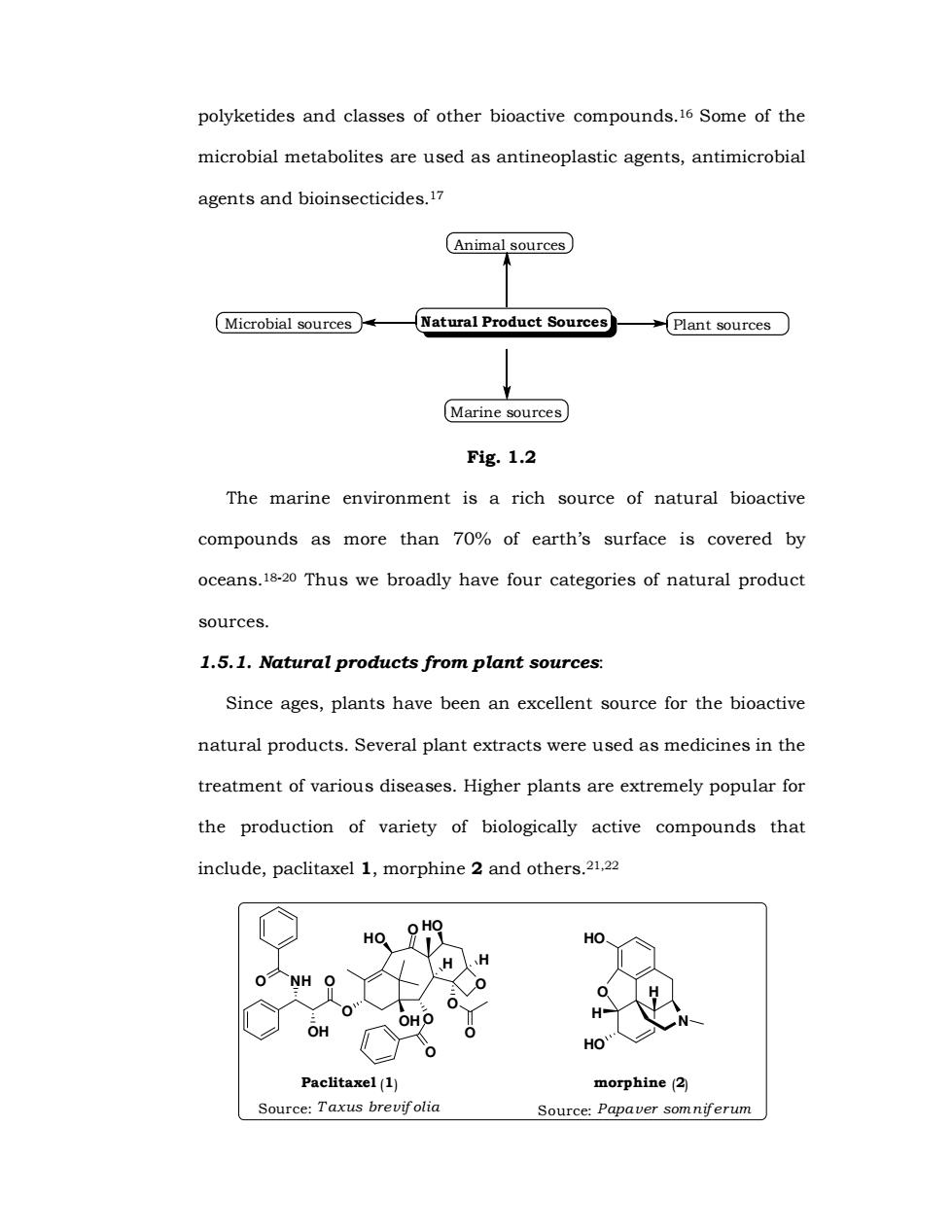
polyketides and classes of other bioactive compounds.16 Some of the microbial metabolites are used as antineoplastic agents,antimicrobial agents and bioinsecticides.17 (Animal sources Microbial sources Natural Product Sources Plant sources (Marine sources Fg.1.2 The marine environment is a rich source of natural bioactive compounds as more than 70%of earth's surface is covered by oceans.18-20 Thus we broadly have four categories of natural product sources. 1.5.1.Natural products from plant sources. Since ages,plants have been an excellent source for the bioactive natural products.Several plant extracts were used as medicines in the treatment of various diseases.Higher plants are extremely popular for the production of variety of biologically active compounds that include,paclitaxel 1,morphine 2 and others.21.22 9 OH HO Paclitaxel(1) morphine (2) Source:Taxus brevifolia Source:Papaver somniferum
polyketides and classes of other bioactive compounds.16 Some of the microbial metabolites are used as antineoplastic agents, antimicrobial agents and bioinsecticides.17 Microbial sources Natural Product Sources Marine sources Plant sources Animal sources Fig. 1.2 The marine environment is a rich source of natural bioactive compounds as more than 70% of earth’s surface is covered by oceans.18-20 Thus we broadly have four categories of natural product sources. 1.5.1. Natural products from plant sources: Since ages, plants have been an excellent source for the bioactive natural products. Several plant extracts were used as medicines in the treatment of various diseases. Higher plants are extremely popular for the production of variety of biologically active compounds that include, paclitaxel 1, morphine 2 and others.21,22 O NH OH O O O O O H O O HO O HO OH H Paclitaxel (1) Source: T axus brevif olia HO O H HO H N morphine (2) Source: Papaver somnif erum
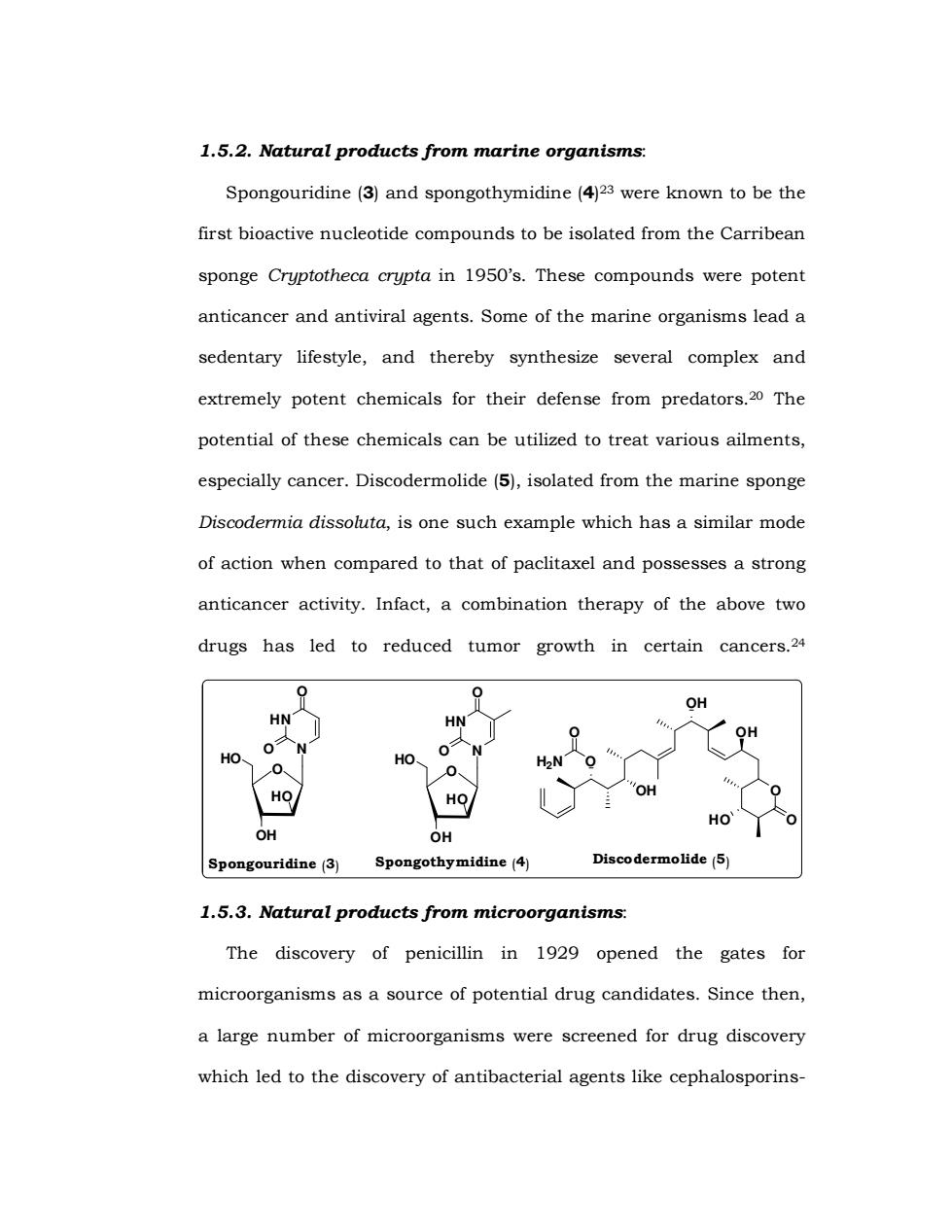
1.5.2.Natural products from marine organisms Spongouridine(3)and spongothymidine(4)23 were known to be the first bioactive nucleotide compounds to be isolated from the Carribean sponge Cryptotheca crypta in 1950's.These compounds were potent anticancer and antiviral agents.Some of the marine organisms lead a sedentary lifestyle,and thereby synthesize several complex and extremely potent chemicals for their defense from predators.20 The potential of these chemicals can be utilized to treat various ailments, especially cancer.Discodermolide(5),isolated from the marine sponge Discodermia dissoluta,is one such example which has a similar mode of action when compared to that of paclitaxel and possesses a strong anticancer activity.Infact,a combination therapy of the above two drugs has led to reduced tumor growth in certain cancers.24 H HN o- -0 HO HN 0 OH OH Spongouridine(3) Spongothymidine(4倒 Discodermolide (5) 1.5.3.Natural products from microorganisms. The discovery of penicillin in 1929 opened the gates for microorganisms as a source of potential drug candidates.Since then, a large number of microorganisms were screened for drug discovery which led to the discovery of antibacterial agents like cephalosporins-
1.5.2. Natural products from marine organisms: Spongouridine (3) and spongothymidine (4) 23 were known to be the first bioactive nucleotide compounds to be isolated from the Carribean sponge Cryptotheca crypta in 1950’s. These compounds were potent anticancer and antiviral agents. Some of the marine organisms lead a sedentary lifestyle, and thereby synthesize several complex and extremely potent chemicals for their defense from predators.20 The potential of these chemicals can be utilized to treat various ailments, especially cancer. Discodermolide (5), isolated from the marine sponge Discodermia dissoluta, is one such example which has a similar mode of action when compared to that of paclitaxel and possesses a strong anticancer activity. Infact, a combination therapy of the above two drugs has led to reduced tumor growth in certain cancers.24 O OH HO N HN O O Spongouridine (3) HO O OH HO N HN O O Spongothymidine (4) HO O O H2N OH OH OH O HO O Discodermolide (5) 1.5.3. Natural products from microorganisms: The discovery of penicillin in 1929 opened the gates for microorganisms as a source of potential drug candidates. Since then, a large number of microorganisms were screened for drug discovery which led to the discovery of antibacterial agents like cephalosporins-
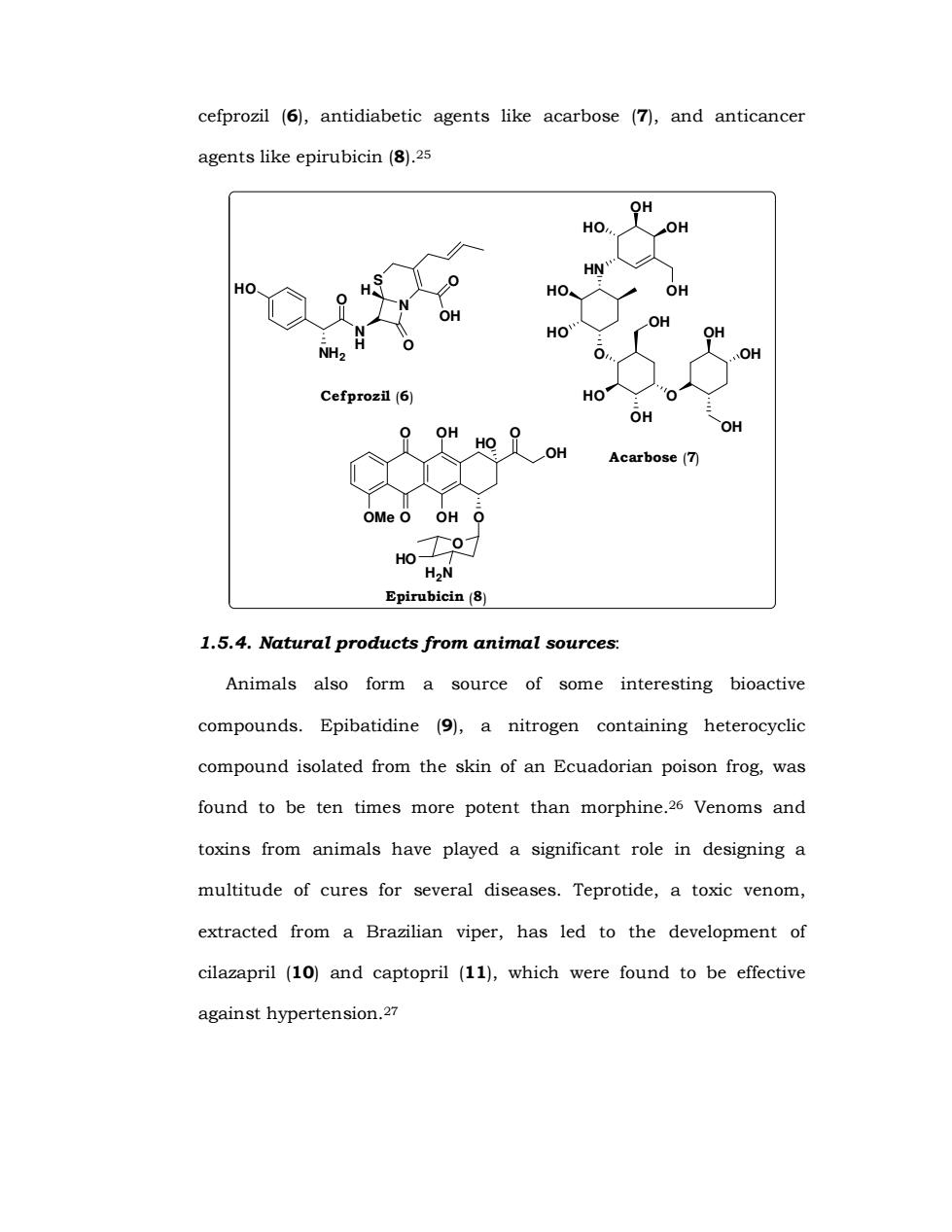
cefprozil (6),antidiabetic agents like acarbose (7),and anticancer agents like epirubicin(8).25 OH HO HO. Cefprozil(6) HO OH OH OH Acarbose(☑ OMe O OH O Ho 7o Epirubicin(8) 1.5.4.Natural products from animal sources Animals also form a source of some interesting bioactive compounds.Epibatidine (9),a nitrogen containing heterocyclic compound isolated from the skin of an Ecuadorian poison frog,was found to be ten times more potent than morphine.26 Venoms and toxins from animals have played a significant role in designing a multitude of cures for several diseases.Teprotide,a toxic venom, extracted from a Brazilian viper,has led to the development of cilazapril (10)and captopril(11),which were found to be effective against hypertension.27
cefprozil (6), antidiabetic agents like acarbose (7), and anticancer agents like epirubicin (8).25 NH2 HO N H O N O S O OH H Cefprozil (6) HN HO OH OH OH O O OH HO HO HO OH OH OH OH Acarbose (7) O O OH OMe OH O OH O O HO H2N Epirubicin (8) HO 1.5.4. Natural products from animal sources: Animals also form a source of some interesting bioactive compounds. Epibatidine (9), a nitrogen containing heterocyclic compound isolated from the skin of an Ecuadorian poison frog, was found to be ten times more potent than morphine.26 Venoms and toxins from animals have played a significant role in designing a multitude of cures for several diseases. Teprotide, a toxic venom, extracted from a Brazilian viper, has led to the development of cilazapril (10) and captopril (11), which were found to be effective against hypertension.27
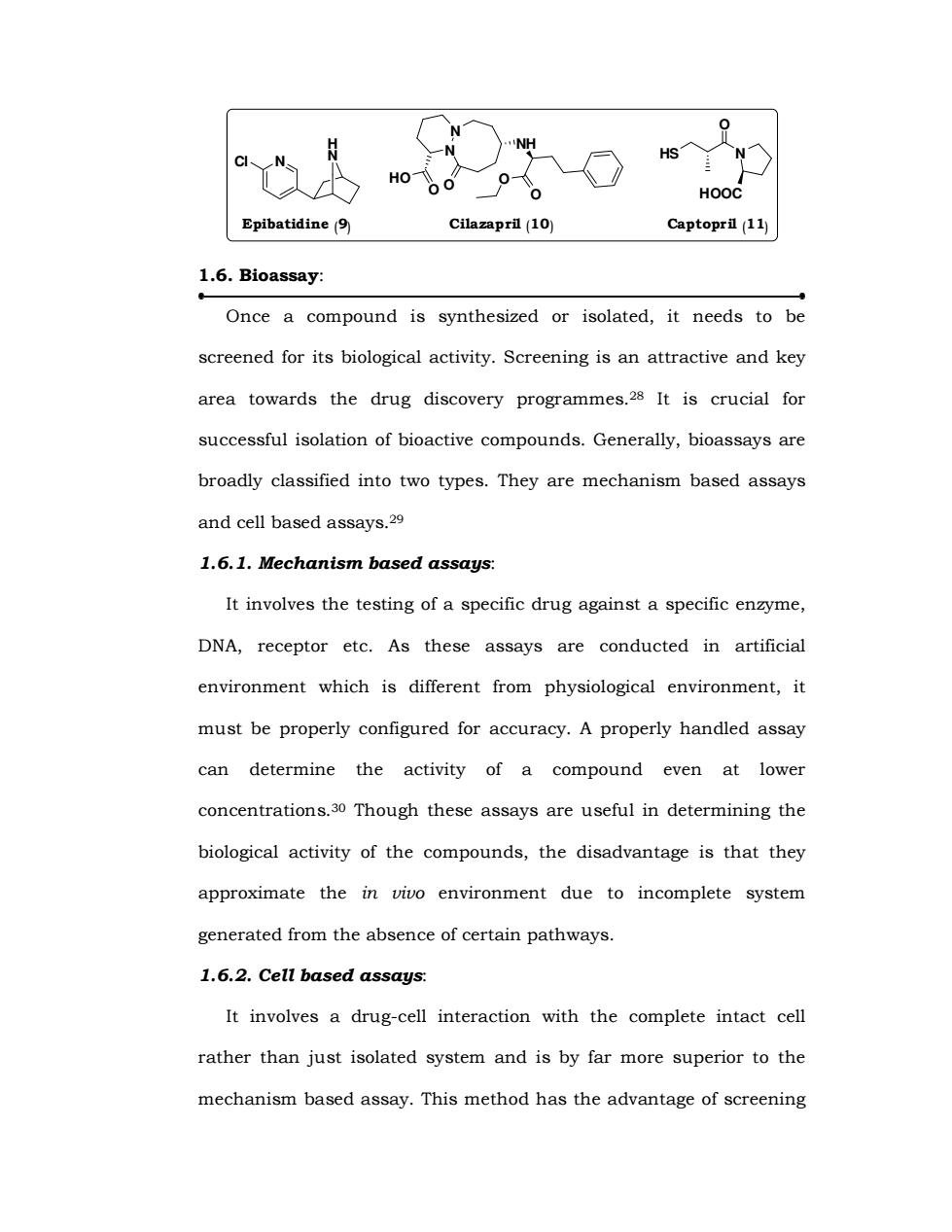
Epibatidine( Cilazapril (10) Captopril(11) 1.6.Bioassay: Once a compound is synthesized or isolated,it needs to be screened for its biological activity.Screening is an attractive and key area towards the drug discovery programmes.28 It is crucial for successful isolation of bioactive compounds.Generally,bioassays are broadly classified into two types.They are mechanism based assays and cell based assays.29 1.6.1.Mechanism based assays: It involves the testing of a specific drug against a specific enzyme, DNA,receptor etc.As these assays are conducted in artificial environment which is different from physiological environment,it must be properly configured for accuracy.A properly handled assay can determine the activity of a compound even at lower concentrations.30 Though these assays are useful in determining the biological activity of the compounds,the disadvantage is that they approximate the in vivo environment due to incomplete system generated from the absence of certain pathways 1.6.2.Cell based assays It involves a drug-cell interaction with the complete intact cell rather than just isolated system and is by far more superior to the mechanism based assay.This method has the advantage of screening
Cl N H N Epibatidine (9) N N HO NH O O O O Cilazapril (10) HS N O Captopr il (11) HOOC 1.6. Bioassay: Once a compound is synthesized or isolated, it needs to be screened for its biological activity. Screening is an attractive and key area towards the drug discovery programmes.28 It is crucial for successful isolation of bioactive compounds. Generally, bioassays are broadly classified into two types. They are mechanism based assays and cell based assays.29 1.6.1. Mechanism based assays: It involves the testing of a specific drug against a specific enzyme, DNA, receptor etc. As these assays are conducted in artificial environment which is different from physiological environment, it must be properly configured for accuracy. A properly handled assay can determine the activity of a compound even at lower concentrations.30 Though these assays are useful in determining the biological activity of the compounds, the disadvantage is that they approximate the in vivo environment due to incomplete system generated from the absence of certain pathways. 1.6.2. Cell based assays: It involves a drug-cell interaction with the complete intact cell rather than just isolated system and is by far more superior to the mechanism based assay. This method has the advantage of screening